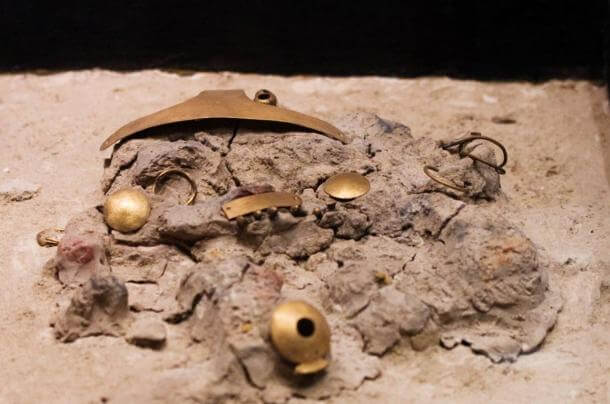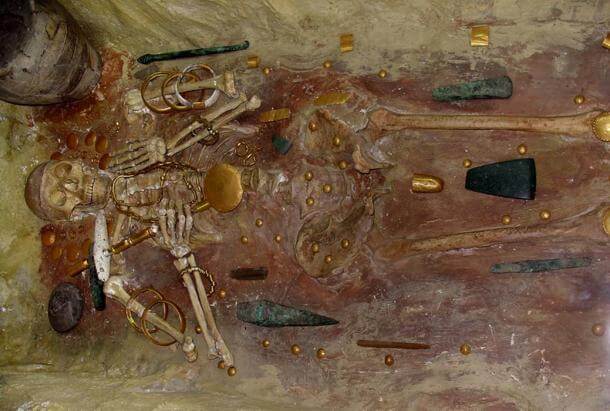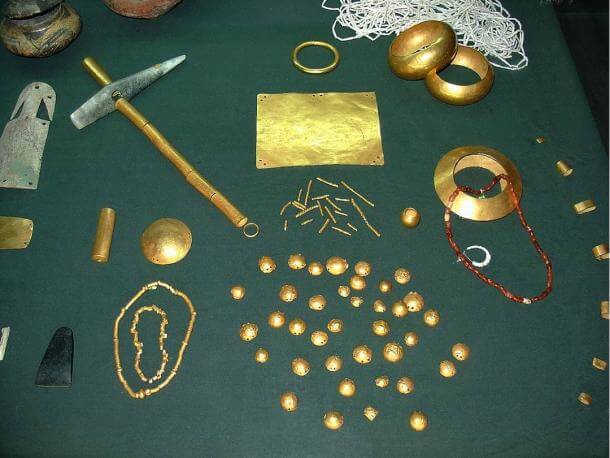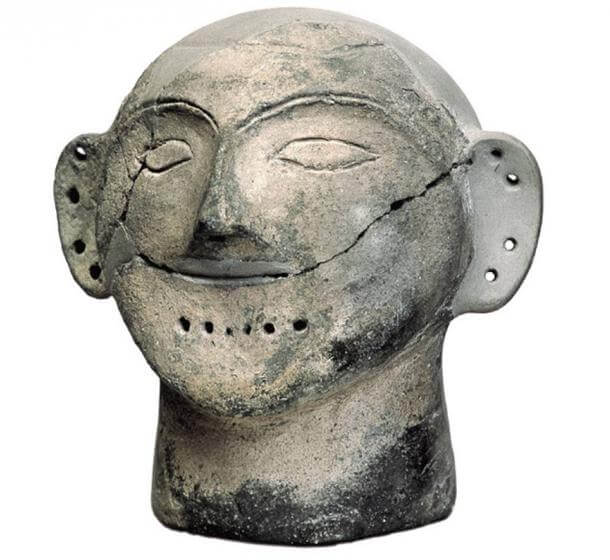
The man from Varna and the richest grave of the 5th millennium B.C
 24. 08. 2020
24. 08. 2020

In 1970, Bulgarian archaeologists encountered an extensive burial ground from the 5th millennium near the present-day town of Varnana. BC, which contained the oldest gold artifacts discovered so far.
Grave No. 43
But the real significance of this locality became apparent only after the discovery of grave number 43. In grave 43 were the remains of a man of high social status buried together with incredible wealth - more gold was found in this grave itself than in the rest of the world from this period.
Most people have certainly heard of the great civilizations of Mesopotamia, Egypt, and the Indus Valley, which are considered to be the oldest civilizations with their typical manifestations such as urbanization, organized administration, and cultural innovation. But few people know of the mysterious civilization that appeared on the shores of lakes near the Black Sea sometime 7 years ago.
Breathtaking Varenská culture
Varna culture, as it is technically called, was not a small and insignificant community that would appear in a remote part of the country in today's Bulgaria and quickly disappear from the stage of history. Instead, it was a surprisingly advanced civilization that was much older than the empires of Mesopotamia and Egypt, and at the same time it was the first known culture to create gold objects.
Varna is also the site of the largest burial ground in South-Eastern Europe, which reflects wealth and cultural customs, complex funeral ceremonies, ancient beliefs and the ability to produce exceptional and perfectly crafted objects. It became known as the European cradle of civilization.
The rise of goldsmithing and wealth
The findings suggest that the goldsmith shop in Varna first appeared between 4600 and 4200 BC Along with advances in the craftsmanship and metallurgy of copper and gold, the locals also gained a valuable means of exchange. Closer ties with neighboring communities in both the North and the South eventually resulted in regular trade relations with the Black Sea and Mediterranean region, which significantly contributed to the development of local society.
The deep bay, along which the settlement in Varna is located, provided a safe berth for ships sailing on the Black Sea, and Varna became a prosperous trading center. The growth of trade allowed local metallurgists to amass wealth, and a social pyramid was soon formed with metalworkers at the top, merchants in the middle, and farmers at the bottom.
Incredible discoveries from a nearby burial ground suggest that Varna was ruled by powerful rulers or kings - but we will get to that. Thus the foundations were laid for the rise of a powerful and prosperous culture, the influence of which permeated Europe throughout the next millennium.
Discovery of an ancient Varian civilization
The first evidence of the existence of the ancient Varian civilization was the discovery of tools, vessels and figurines made of stone, flint, bone and clay. Then came the incredible discovery that newspapers around the world wrote about. In October 1972, the digger Raycho Marinov came across an extensive burial ground from the Copper Age, which contained the oldest gold objects discovered so far.
It became one of the most important archaeological discoveries in Bulgaria. Extensive research was launched under the leadership of Mikhail Lazarov (1972–1976) and Ivan Ivanov (1972–1991), which revealed for the first time the grandeur of the Varenská civilization.
More than 300 graves were discovered in the cemetery, from which more than 22 exceptional objects come, including more than 000 gold artifacts with a total weight of 3000 kg. Other significant finds from these graves included copper, high-quality flint tools, jewelry, beads, shells of Mediterranean bivalves, pottery, and obsidian blades.
An analysis of these graves revealed that the Varen culture had a highly structured society - members of the elite were buried in shrouds with sewn gold ornaments and their graves were filled with many treasures including gold ornaments, heavy copper axes, selected jewelry and richly decorated pottery, while others had simple funerals with only a few alms.
The richness of the grave 43
Many elite burials were discovered in the burial ground in Varna, but one of them, grave 43, was especially rich. Inside this tomb, archaeologists discovered the remains of an important man who was probably the ruler or leader of society. Only in this tomb itself was there more gold than in the rest of the world during this period. The man, known as the Man of Varna, was buried with a scepter - a symbol of high status or spiritual power - and his penis was protected by a pure gold case.
This funeral is extremely important not only because of its funeral equipment - it is the oldest known elite male funeral in Europe. Previously, the most magnificent funerals were reserved for women and children. Marija Gimbutas, a Lithuanian-American archaeologist who is known for her claims that Neolithic sites throughout Europe provided evidence of a matriarchal pre-Indo-European society, believes that it was at the end of the 5th millennium that men took power in Europe. And indeed, it was found that during this period, men began to have far more lavish funerals in the Varnesian culture.
Complex funeral ceremonies of the burial ground in Varna
The tombs at the burial ground in Varna provided far more than just rare artifacts and evidence of the stratification of society; the construction of the tombs and the way the dead were placed also provided valuable insights into the faith and complex burial practices of this ancient civilization. It became clear to the scientists that the men and women were placed in the grave in different positions - the men were lying on their backs and the women were placed in a crouched position on their sides.
But the most surprising discovery was that some graves did not contain skeletons at all, and these "symbolic graves" were the richest in terms of gold and other rare objects. Some of these symbolic graves, the cenotaphs, also contained human masks of unfired clay placed in the area where the deceased's head would be.
The graves containing the clay masks also contained golden amulets in the shape of a woman placed in the space where the neck would be located. These amulets associated with pregnancy and childbirth suggest that these "funerals" were for women. Further evidence is provided by the fact that no ax-hammers were found in these cenotaphs, but in all of them copper needles, flint knives and simple yarns for spinning threads were present.

Reconstruction of a symbolic tomb containing an anthropomorphic clay face. The original was found in a copper cemetery in Varna and dates back to the 4th millennium BC
The fall and legacy of Varnesian culture
At the end of the fifth millennium BC, the once strong and powerful Varenská culture began to disintegrate. The collapse of the Varian civilization is thought to have been caused by a combination of factors, including climate change, which has turned arable land into swamps and wetlands. Another factor was the fall of warriors on horses from the Eurasian steppes.
Although Varna's civilization left no direct descendants, members of this ancient culture left a deep and lasting legacy and paved the way for the emergence of subsequent European civilizations. Their metal skills were unparalleled in Europe, and indeed throughout the world, and their society showed the hallmarks of a highly developed and advanced civilization. They have also developed a social hierarchy and centralized government - individuals or institutions that monitor and ensure the proper functioning of society. All the basic principles of today's society were present here and represent a model of civilization that is still valid today.
Tip from Sueneé Universe
I Hjong-kwon: Sansa - Buddhist monasteries in the Korean mountains
Buddhist monasteries - places that purify and open the mind. Do you know how it works in them? The publication contains over 220 photographs.
The poet, traveler and publicist I Hjong-kwon (1963) plastically describes twenty-two South Korean localities and their distinctive world in this full-color publication. It introduces us to Korean history, Buddhist philosophy, fine arts, quirky legends as well as Zen poetry and the geography (and even the geomanicity) of the mountains - all complemented by more than 220 photographs. He also pays great attention to architecture, especially the connection between the arrangement of individual buildings in the sansa space and the concept of the path to spiritual awakening in the Buddhist sense.





 1
1



